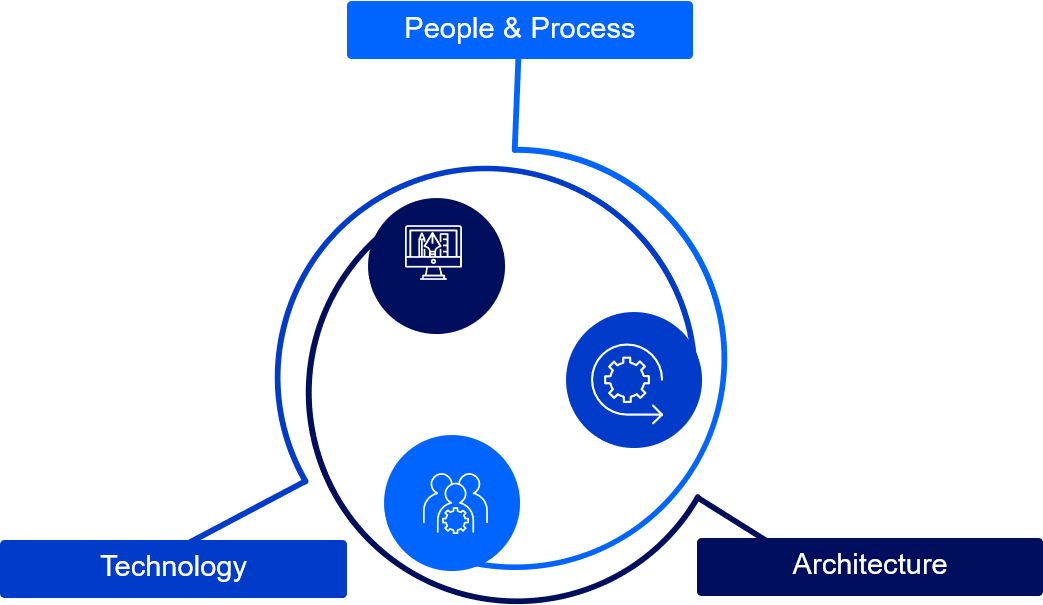To drive digital transformation, organizations must tap into an ever-growing set of applications, processes, and information sources across multiple clouds all of which significantly expand the enterprise’s need for modern integration capabilities. However, Gartner states, “
Integration has become an obstacle to success because traditional, centralized and systematic integration approaches cannot cope with the volume and pace of business innovation.”*

To succeed in digital transformation, we must modernize our approaches to integration.
Why?
Most businesses are engaged in one or more of the following initiatives:
- Digital Transformation – customer-centric innovation
- Increasing business agility – speeding time to market, increasing revenue
- Cloud and SaaS adoption – in support of increasing business agility, but also improving cost models
- AI – improving customer service
- Business Process Automation – to increase customer satisfaction and reduce costs
Proactive enterprises are leveraging data from across their organizations bringing new data sources to fuel their insights. They are also integrating new applications to glean even more customer information and expanding into new markets and channels with new offerings. If these initiatives are not on your radar, they should be. Your competition is most likely already starting.
Because of these initiatives your data is no longer centrally located. It resides on:
- Multiple Public Clouds
- Private Clouds
- Legacy Systems
- Internet of Things
- Weather Data
- Mobile / Other UI
- Social media
- Partners / 3rd party systems
The challenge to be successful in our initiatives is to bring the data together from these diverse locations. With the need for agility, funneling all integration tasks through a centralized mechanism and team is simply not going to work. This means we must do more decentralized and less centralized integration.

Kim Clark addressed several aspects of this (for APIs) in his blog, “
Is API management a centralized or decentralized approach?” However, Kim would also add that the points made apply not just to API Management, but also to application integration, messaging, events, information, and files – all types of integration - need to be modernized or you will be slowing down your digital transformation.
Modernizing Integration
A decentralized, microservices-aligned architecture that supports multiple domains, delivery models, endpoints and personas is required to support an agile integration approach. This involves not only technology, but architecture, people, and processes as well. We will address all of these (across this blog and part 2 to follow).

While many data sources are under your control, others are not. Many forms of integration are required because they solve different problems:
- APIs - Driving the consumption of business assets securely and easily. Manage access to services inside/outside your company and open data securely to share and monetize
- Application Integration - Connect applications on-premise or in the cloud (or both) and synchronize key data elements across applications
- File Transfer - Move vast amounts of data rapidly and predictably. Adopt cloud platforms even when data is very large
- Messaging- Reliable data communication across application boundaries
- Data - Cleanses and prepares data to present a consistent view of the customer, drives data for analytics
- Events - Respond to events before the moment passes creating responsive and personalized customer experiences
Architecture and Technology
To support the need for agility and the multiple domains an agile integration architecture is required providing fine grained deployment and decentralized ownership across a cloud-native platform.

The technology platform needed to implement the architecture must support a vast array of applications and data sources, support all the modes of integration, and allow for deployment in any location.
 IBM Cloud™ Integration Platform
IBM Cloud™ Integration Platform offers a single, unified platform for all your integration needs. Cloud Integration Platform can help modernize your integration capabilities and achieve digital transformation with your new integration projects, it delivers these capabilities:
- Provides a new, simple and fast way to buy the entire suite of integration capabilities in one product
- Enables fast deployment with an enhanced and simplified install experience in the cloud or data center of your choice. Can be deployed behind your firewall or into any other secure location.
- Easy to manage with common management and interaction capabilities.
- Included are capabilities for Application Integration, API Management and secure gateway, Events, Messaging, and File transfer.
Next week I will continue this discussion with a focus on
People and Process.
To understand more about IBM’s thoughts on the API Economy visit the IBM
API Economy website. IBM API Connect is IBM’s complete foundation to Create, Secure, Manage, Test, and Monitor APIs. You can find more information about IBM API Connect at the
API Connect website. And you can also experience a
trial version of API Connect.
If you have questions, please let me know. Connect with me through comments here or via twitter
@Arglick to continue the discussion.
* Source: Gartner-Modernizing Integration Strategies and Infrastructure Primer for 2018
#agile#agileintegration#agileintegrationarchitecture#APIConnect#APIeconomy#APIEconomy#APImanagement#APIscience#APIstrategy#api_strategy#APIConnect#apimgt#apis#applicationintegration#BusinessStrategy#CIP#Cloud#cloudintegration#cloudintegrationplatform#events#experienceAPIs#filetransfer#ibm
#ibmapimgt#Integration#integrationarchitecture#IntegrationModernization#MarketTrends#messaging#modernization#TechnicalStrategy#think_apis